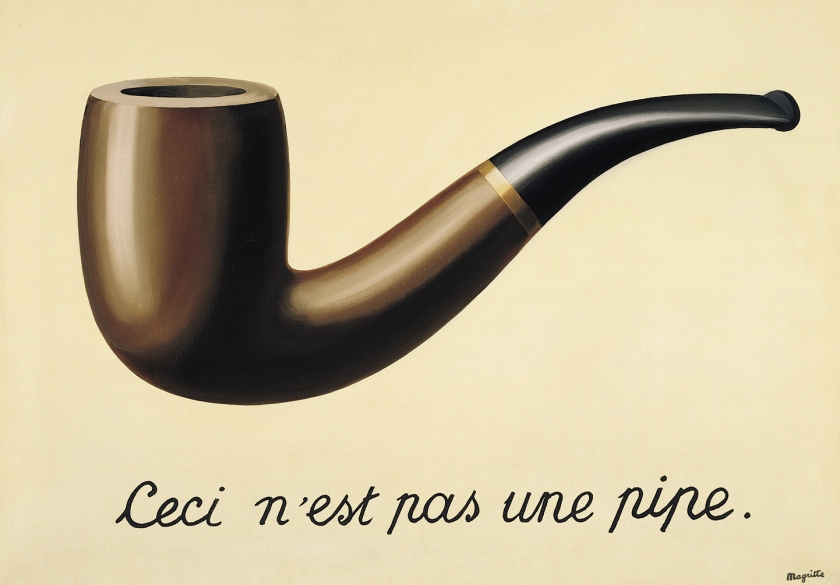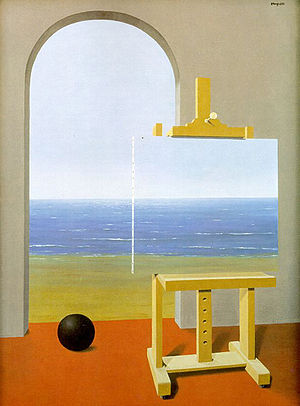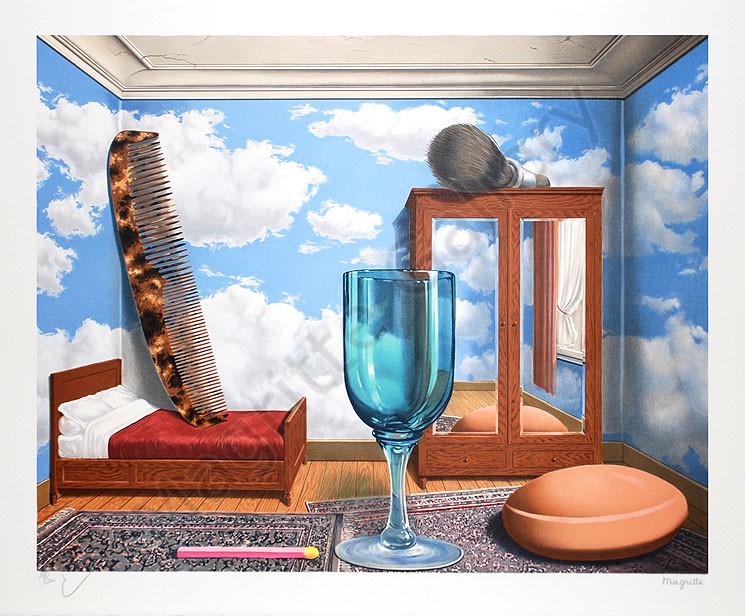Rene Magritte
Rene Magritte was a Belgian Surrealist artist. He became famous his surrealist paintings that were often witty and thought-provoking and his work challenges observers’ preconditioned perceptions of reality. Below is a famous quote by Rene Magritte:
| “ |
It is a union that suggests the essential mystery of the world. Art for me is not an end in itself, but a means of evoking that mystery. |
” |
|
— René Magritte on putting seemingly unrelated objects together in juxtaposition
|
Magritte’s work frequently displays a collection of ordinary objects in an unusual context, giving new meanings to familiar things. The use of objects as other than what they seem is typified in his painting, ‘The Treachery of Images’ which shows a pipe that looks as though it is a model for a tobacco store advertisement. Magritte painted below the pipe “Ceci n’est pas une pipe” (“This is not a pipe”), which seems a contradiction, but is actually true: the painting is not a pipe, it is an image of a pipe. 
Magritte used the same approach in a painting of an apple, inserting a caption with the image of the fruit. In these “Ceci n’est pas” works, Magritte points out that no matter how naturalistically or realistically we depict an object, we never do catch the item itself.
Among Magritte’s works are a number of surrealist versions of other famous paintings such as his The Human Condition series(1933, 1935) or The Promenades of Euclid (1995).


Magritte’s use of ordinary objects in unfamiliar spaces is joined to his desire to create poetic imagery. He described the act of painting as “the art of putting colors side by side in such a way that their real aspect is effaced, so that familiar objects become united in a single poetically disciplined image. The poetry of this image dispenses with any symbolic significance, old or new.”
René Magritte described his paintings as “visible images which conceal nothing; they evoke mystery and, indeed, when one sees one of my pictures, one asks oneself this simple question, ‘What does that mean?’. It does not mean anything, because mystery means nothing either, it is unknowable.”
We will now look into one of his most famous paintings, “Les Valeurs Personnelles” (1952):

Description
In this painting, there are several commonly seen items, namely a comb, matchstick, shaving brush, bar of soap, and wineglass that are blown up to human-sized proportions. The items are arranged randomly and without any order. Their magnified scale gives the viewers a sense of presence and that the room is completely occupied, also at the time, threatening the viewer’s comfortable familiarity of these common objects, suggesting that there is no room for the viewers. The background, or rather the wallpaper of the room is of fluffy whit clouds against an azure blue sky which feels seemingly calm and dream-like. From the mirror’s reflection, a white curtain can be seen.
Analysis
A variation of colours is being used in the painting and the colours are almost identical to the real-life objects themselves, making the objects look incredibly realistic. There is also balance achieved between the warm and the cool colours, most of the warm colours used are brown while the cool colours are mostly made up of blue, hence, adding a touch of vibrance to the painting.
The brushstrokes that Magritte employed is extremely fine, almost invisible and extremely well-blended, allowing the painting to look realistic and in its most natural state, while making the painting polished and refined at the same time. With the goal of letting viewers relate to the painting, Magritte managed to portray the objects naturalistically so that viewers can relate to the objects that they see in the painting.
The detailed shadows and tones that are given to the objects makes the realistically painted objects look well-modelled and three-dimensional . The lines and higlights also gives the objects the curvatures and edges that they should have, also at the same time, creating the different textures of the objects, for example, the highlights and the fine lines that are being used to paint the glass makes it look extremely realistic even in terms of the reflection of light on the glass, the viewers can even see the depth of the glass through the painting.
The direction of light seems to come from the right side of the painting, where the window is located, as the shadows of the objects fall on the left side of the painting. The addition of light and tones also allows the painting to become more lively and vibrant.
The composition of the painting seems to be rather symmetrical, with the glass being at the centre of the painting and three objects on each side of the paintings, scattered randomly.
The overall mood of the painting is rather calming and serene due to the balanced use of cool and warm colours that adds a touch of exuberance and joy to the painting, also the clouds create an illusion of calmness, however, as much as the painting gives off a sense of calmness, it also gives off a sense of confusion and puzzlement, with the unusal proportion of the commonly seen objects and the size of the room in comparison to these onjects. The scale of the different objects scream surrealism but the details of the paitning makes the onjects look naturalistic and raw ; hence, prompting viwers to rethink the objects that used to be familiar to them.
Interpretation
Personally, I feel that all these objects that are depicted in this painting belong to Magritte himself as they would have been readily at hand in Magritte’s Brussels flat, which doubled as his studio. Also, he once wrote “Painting for me is a description of a thought. The thought can only consist of visible objects, which exist in my head as clear images. A comb for example, I make a lot of drawings of it. That in turn will suggest other images — a wineglass, a shaving brush” Hence, it is indeed possible to say that these objects are his personal objects, moreover, by using his own personal belongings, it is easier for him to tell a stroy using these objects, at the same time, also bringing in his own personal emotios and values that he relates the object to. I feel that Magritte had included these commonly seen items around the house to connect with the viewers, causing them to thik about their own personal values and what holds meaning for them, but more importantly, to get them to think of what is significant in their lives. Although the objects depicted in the painting, even the bedroom, might seem familiar, however contrary to the intimacy we commonly attribute to a person’s sleeping quarters, this room seems strangely, sterile devoid of the human touch, emmiting a sense of isolation and a world in which we humans do not belong in. Instead of human inhabitants, enormously scaled personal items stand eerily at attention. By placing these objects together, Magritte causes us to rethink our own relationship to ordinary personal items, to question our thoughtless and routine interactions with familiar objects, and to stop and assess the values they represent.
Bed and Matchstick
The tightly made bed reflects the same formal rigour as the rest of the painting. But its proximity to the matchstick (in French an “allumette”) suggests a play on the French phrase “Tu m’allumes,” or “You turn me on.” This visual pun conveys both Magritte’s sense of humour and his appreciation of the surrealist’s appreciation of the erotic.
Comb
Like the soap and shaving brush the comb is used to present a socially accepted exterior. Resting on the bed like a standing figure, it’s placement draws attention to the affinity between the pillow upon which one rests one’s head, and the comb, which is used to groom one’s hair after resting, prior to returning to the company of polite society.
Sky
The floorboards and ceiling imply that the scene takes place within a room. Yet the sky painted on the walls and reflected in the armoire mirror challenge this assumption. Playing with notions of mental and atmospheric space, Magritte suggests that the breadth of this room is as unbounded by its physical limits as is human imagination.
Wardrobe
As with the surrealists, Magritte used the iconography of the mirror to represent psychological space and the realm of fantasy, as possibly enhanced by the sky reflected in the armoire mirror. The armoire itself suggests a psychological interior, perhaps holding clues to the life of the room’s inhabitant.
Soap
The soap and shaving brush suggest the importance of grooming to the inhabitant of the room. Yet the careless placement of the shaving brush atop the armoire alludes to the ever-present a malady of the middle class the desire to live freely in one’s mental interior under the constant pressure to present a socially acceptable exterior.
Wine Glass
The wine glass is the single item in this composition that does not traditionally belong in the bedroom. It is also the only object in the room to assume a fully upright stance, perhaps serving as a stand in for the room’s inhabitant or a guest. The curvaceous glass might even imply a feminine presence, given its positioning beside the suggestive matchstick.
Judgement
I feel that this painting is indeed successful in making viewers rethink their own relationships with the their personal items and to think more about what the items represent and how it is significant to them. I think that the message that Magritte wants the convey to the viwers come as a strong and impactful one as these objects are usually what people would take for granted and not give a spare thought about using them and the impact comes visually as an effect of the unusally scaled items, making them realise that these objects might be more than what they mean. By analysing this painting, I feel that viewers would indeed start to value and think about their personal items more and relate a personal value to the object, making them treasure their objects more. I think that the message that Magritte wants to bring across to the readers can also be applied to daily life and everyone;s life essentially as they should always treasure the things and people around them and not take them for granted.
Overall, I really like this painting and the message that the artist tries to bring across to the viewers.
Response: My Personal Values Room

In response to Magritte’s work, I have made my own collage of seven items that holds personal value to me.
Clock
I believe that time means a lot to everybody, including me. I feel that time is always around me and taking part in every single part of my life, also it is the one that stresses me out the most. As time is passing by without stopping, I feel that it is best to use time wisely and to live happily because there is no turning back for time.
Books
I feel that books are my passports to the different parts of the world, and to even to worlds that do not exist. Without spending a lot of money, I can get to know more about the world, know more about others’ stories and to gain more knowledge about the world. By reading books, I feel relax and being able to think more clearly and learn how to live life more wisely.
Camera
My camera to me is like my second pair of eyes, recording and capturing the world that I see and that I normally don’t, and storing them for later use. I feel that my camera is a unique pair of eyes because when I use my camera, I notice thing that I’ll never notice usually and it also allows me to record moments that I never want to forget and people and things, or even places that tell a different story.
Comb
The comb is a personal grooming item and to me, it means personal image. With society being so judgemental these days, I feel that there is indeed a need to give others a good impression of myself, hence, i think that the comb is very important to me in terms of being able to remain in my best shape and confidence needed to face the world.
Phone
My phone is my ticket to connection with the world. With the phone being a convenient device for communication, I feel that it represents a part of me in communication with the society, be it friends or family. Without wasting much time, I could contact the person that I want within seconds. Although I treasure my phone a lot as it opens the door to a bigger world (internet), I feel that traditional communication would work better for a person like me.
Speaker
The speaker to me is a zone where I can be isolated from the world and be free of all thoughts. I think of it as a personal space, a sanctuary, where only I exist, where time doesn’t pass and everything in the world stops in movement. When I use the speakers, I feel like I’m carefree, drifting in a space that is mine and that is the only place where I can truely relax and rest.
Stuffed Hippo Bolster
I feel that it is companion that I can talk to whenever I have worries and discontentment, a companion without comments and won;t speak back, but just continue to listen. To me, it is like a friend that would not betray and would always be there for me.
The objects are arranged randomly as I feel that the uses of these objects vary from time to time and from situation to situation but the clock, in terms of scale, is the biggest as it makes up my life and is always around me, even when now, while I’m typing this text. Although the items are arranged randomly, just like Magritte’s painting, there is also a line of symmetry in the collage. The comb is the centre of the collage, with three items ofeach side of the collage, hence, turning out to be balanced. The items are in close proximity to each other, meaning that they are always interconnected to my life in some very close way and that my life would never be the same without any of these items.
 Sketch
Sketch



 The Kiss(1908)
The Kiss(1908)






















